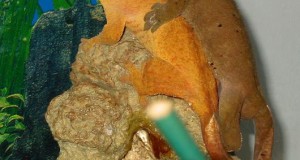Day Geckos, those brilliantly-clad gems of the lizard world, are growing in popularity in zoos and private collections alike. Small wonder – the 52 described species, all placed in the genus Phelsuma, are active by day (of course!) and, when properly kept, quite willing to breed and exhibit a wide range of behaviors in moderately-sized enclosures. Feeding Day Geckos isn’t hard, as most eagerly feed upon crickets and mealworms, but their nutritional needs will not be met on this all-too-common diet.
If your Day Geckos are to live long, healthy lives and reproduce, a good deal of effort must be put into providing a varied diet. Fortunately, most herp keepers find the extra work – such as collecting or breeding “alternative” insect species – enjoyable, and well worth their efforts. The following foods and techniques have served me well throughout my zoo and private animal-keeping careers. The information can be applied to most species, including Standing’s, Gold Dust, Giant, Spotted, Lined and Peacock Day Geckos. However, details will vary. Please post below for information on individual species.
Natural History
Madagascar is the center of Day Gecko diversity, but several species inhabit the Andaman, Comoros, and Round Island groups, Mauritius and the Seychelles. Introduced populations are established in Hawaii, East Africa and Florida.
Day Geckos are highly arboreal, and favor rainforests and moist woodlands. Although some have adapted to life around villages, many are threatened by habitat loss.
Feeding
Insects and Other Invertebrates
A highly-varied diet is essential if you are to have success in keeping Day Geckos. Crickets and mealworms alone, even if powdered with supplements, are not an adequate diet for any species. Most fare best when fed on a near-daily basis.
The diet should consist of roaches, sow bugs, crickets, butterworms, waxworms, cultured houseflies, silkworms, phoenix worms, and other commercially available invertebrates. Insects should be provided a healthful diet for several days before use (please post below for further information).
If possible, offer wild-caught insects regularly (avoid pesticide-sprayed areas, and learn to identify stinging and toxic species; please see articles linked below). Moths, beetles and their grubs, grasshoppers, tree crickets, earwigs, “smooth” caterpillars, small katydids, crane flies, harvestmen, leaf hoppers and a variety of others will be eagerly accepted. Your pets will definitely show greater “enthusiasm” towards novel foods! I credit some of the successes that I and co-workers have had, with a variety of herps and birds, to the use of wild-caught insects. The Bug Napper Insect Trap will simplify insect collection.
Canned silkworms and grasshoppers offered via feeding tong, are an ideal means of introducing variety to the diet.
Nectar Mix
Free-living Day Geckos consume a surprising amount of nectar, ripe fruit, pollen and sap. A mixture of tropical fruit baby food, honey and/or molasses, Avitron Bird Vitamins, ReptiCalcium with D3 (or a similar product) and enough water to achieve a syrupy consistency, should be offered 3 times weekly.
Experiment with the ingredients, and add a bit of crushed ripe papaya, mango and banana on occasion. Most individuals prefer to take nectar from cups suspended above-ground.
Supplements
Useful food supplements include Zoo Med ReptiCalcium or a similar product (most meals) and a vitamin supplement (i.e. Reptivite with D3) 2-3 times weekly.
Other Considerations
While UVB exposure is considered essential in Day Gecko husbandry (so that Vitamin D3 can be manufactured in the skin), there is evidence that at least some species can do without, especially if they have access to a highly varied diet. Please see this article and be sure to post your thoughts below.
Day Geckos will not thrive without a properly designed terrarium equipped with an appropriate source of UVB light (but please see above). Please see this article for information on setting up a Day Gecko enclosure.
Among the Day Geckos’ nearly 1,000 relatives (Family Gekkonidae) we find some of the rarest and oddest of lizards, as well as the best-known of reptilian pets. Please see this article to read more about geckos of all kinds.
Further Reading
Collecting Insects for Captive Reptiles and Amphibians (please see articles linked at end as well)
 That Reptile Blog – Reptile, Amphibian and Exotic Pet Care and Information
That Reptile Blog – Reptile, Amphibian and Exotic Pet Care and Information






